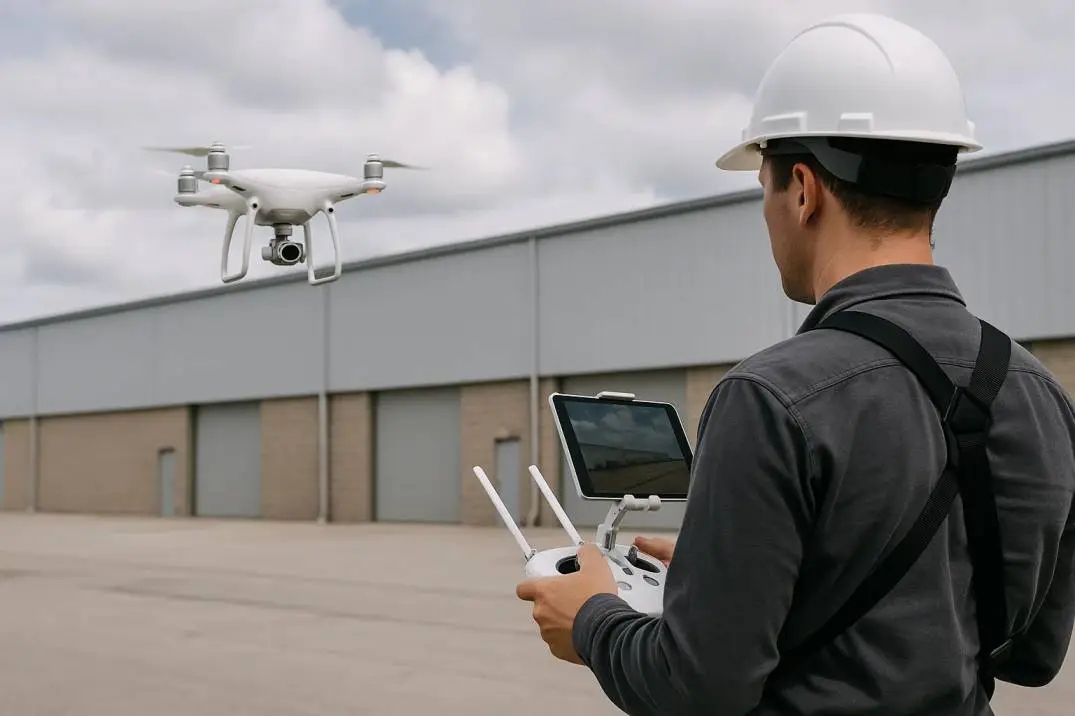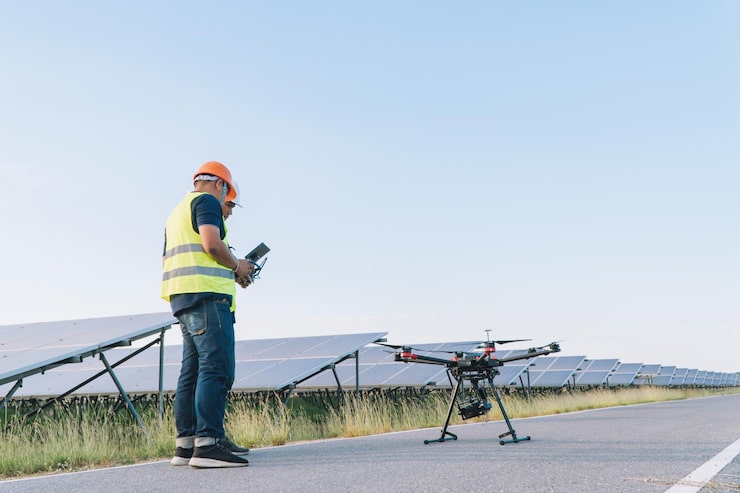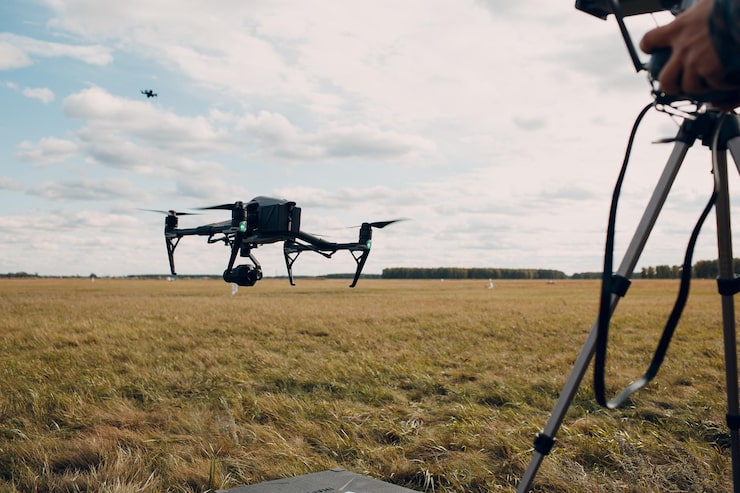
Drone Commercial Property Inspection: Accuracy And Safety
Drones are revolutionizing the way commercial property inspections are carried out. They make it easier for real estate professionals, property managers and construction companies to do their work. Drones can offer a more intelligent (and cost-effective and safe) alternative to traditional forms of inspection.
In fields like domain, development, and framework administration, precise property assessments are key. They help spot potential issues and ensure compliance with building codes. Combining drone innovation with property reviews helps businesses. It boosts appraisal accuracy and improves operational security.
In this post we’d like to explore some advantages of using drones for a commercial property review. We’ll look at how they enhance accuracy and safety. Finally, we’ll also talk about drones being developed for while you inspect property. We’ll discuss the equipment to use and what techniques work best.
Why Drones Are Getting to be Fundamental for Commercial Property Inspections?

Takes time to inspect commercial properties with platforms, ladders or cranes. It can also get expensive, and is not without risk. Many auditors must be able to access hard-to-reach spots. That can create unsafe conditions and slow things down.
Read Also: The Best Drone for Wedding Photography and Videography 2025
Drones are a flexible way to get eyes on buildings, rooftops and tough-to-reach spots in short order. Here are a few reasons why drones are invaluable for commercial property inspections:
Cost Effectiveness: Drones cut down on costly equipment like platforms, cranes, and helicopters. They also lower labor costs since fewer faculty are required to conduct the inspection.
Time Investment funds: Drones can cover huge regions in a brief sum of time, permitting auditors to total their appraisals rapidly. This is crucial for large commercial properties. Here, standard review methods can take days.
Safety: Drones eliminate the requirement for auditors to work at height, another possible cause of fall, accident or injury. Aerial assessments provide a secure way to examine such things as rooftop buildings or tall other challenging structures.
Drones outfitted with high-resolution cameras and sensors can capture detailed photos and videos of a property. This is helpful if inspectors want to collect accurate and useful data for their reports.
Real-Time Get to: With Drones, information can be gotten to and checked on in real time. This provides quick insights into the property's condition. It helps businesses make faster and smarter decisions.
Accuracy in Drone Commercial Property Inspections

One of the main advantages that drones offer for commercial property inspections is accuracy. Data collection is amenable to technological enhancements through drones. This features high resolution cameras, thermal sensors and LiDAR (Light Detection and Ranging) systems.
1. High-Resolution Cameras
Modern Drones are prepared with cameras able of capturing pictures and video in ultra-high determination (up to 4K and past). This lets property reviewers take clear, detailed photos.
Such images can be used to identify problems like cracks, leaks or other damage. The scale of organisation also reinforces the ability to focus on local ranges for small features. This is beneficial in generating more fine-grained assessment reports.
2. Warm Imaging
Thermal drones identify temperature differences on surfaces. This helps auditors hear problems they can’t see, such as water leaks or carpet problems or heating and cooling inefficiency. These drones are equipped with infrared cameras that pick up hot patterns.
They pick out hard-to-spot regions of the spectrum that are very faint or entirely invisible to the naked eye. It's particularly handy for inspecting rooftops, walls and ceilings in commercial buildings. Spills or damage may be invisible at first.
3. LiDAR (Light Detection and Ranging)
LiDAR innovation is another capable apparatus utilized in drone-based property assessments. LiDAR sensors use laser beams to measure distances between the ground and the surface below.
This information is used to create accurate 3D models of the property. Reviewers can then assess critical details and spot any potential issues. LiDAR is great for mapping large commercial properties. It provides precise estimates that traditional methods struggle to match.
4. Geospatial Information & Mapping
Drones can be fitted with tools to gather geospatial data, such as GPS and RTK (Real-Time Kinematic) systems. This allows for precise area tracking, ensuring that review data links to specific coordinates.
Auditors can use advanced maps to overlay this information. This helps them analyze and report the property's format and condition with great precision. This geospatial information also helps when planning reports or sharing data with stakeholders.
Drone Commercial Property Reviews: Security Considerations
Drones provide a key security advantage, but some concerns remain. We must address these issues to ensure that drone inspections are done carefully and safely.
1. Administrative Compliance
Drones are regulated by government bodies in many countries, including the United States and the UK. In the US, it’s the Federal Aviation Administration (FAA), while in the UK, it’s the Civil Aviation Authority (CAA).
You Must Also Like: What Is the Best Drone for Real Estate Photography for 2025?
Here are instructions on how to fly drones in business settings. They span most weight, height restrictions and no-fly zones. In the United States, drone operators conducting commercial property inspections must have what’s called a Part 107 certificate from the F.A.A.
Businesses must check that the ramble administrator is fully licensed. They should also make sure they follow local rules before a review. Disappointment in following these rules can result in fines or legal action.
2. Pre-Flight Security Checks
Drones, like any other equipment, need regular support and pre-flight checks. This ensures they work properly. A ramble administrator should check the drone’s batteries, propellers, and sensors before each flight. This ensures the equipment is safe to use. Routinely upgrading the drone’s program and firmware is also fundamental to cut the hazard of glitches during an inspection.
Additionally, assessing climate conditions is basic some time before flying a drone. Strong winds, rain, or low visibility can affect the drone's stability and threaten the safety of the operation. Always check security before your flight. If conditions aren’t ideal, delay your trip.
3. Working inside Visual Line of Sight
To ensure safety and meet regulations, drones should always be flown within the operator's line of sight. This is especially important in commercial property reviews. Deterrents like control lines, trees, or nearby buildings can disrupt ramble routes. Keeping the ramble inside the operator's sight minimizes the chance of collisions and mishaps.
4. Protections and Liability
Drones reduce the risk of injury to staff during inspections, but accidents can still occur. Drones may crash due to specialized glitches, administrator blunder, or natural variables. Businesses using drones for property reviews should ensure they have proper drone insurance.
This protects against property damage, liability claims, and equipment loss. Also, when hiring a third-party ramble benefit, make sure the administrator is a provider and has enough liability coverage.
Applications of Ramble Assessments for Commercial Properties
Drones can be used in many assessment situations across different types of commercial properties. A few of the most common applications include:
1. Roof Inspections
Reviewing commercial building rooftops is often tricky. They are high and can damage frameworks or steps. Drones can quickly fly over rooftops. They capture clear images and thermal data. This helps spot spills, breaks, or wear and tear. This makes schedule roof assessments much more proficient and cost-effective.
2. Development Location Inspections
Drones are invaluable on development sites. They can check progress, check equipment, and assess the safety of buildings under construction. They can capture aerial footage of large construction sites. This gives a clear view of progress and helps spot any potential issues early on.
3. Office Management
Drones can check the condition of big commercial properties. This includes shopping centers, warehouses, and office buildings. They can check exteriors, stopping parts, HVAC systems, and other hard-to-reach areas. This helps ensure everything is working correctly. Drones help reduce downtime. They ensure that support issues are addressed quickly.
4. Protections Assessments
Drones can help insurance companies quickly assess property damage from climate events or other unexpected incidents. This speeds up claims handling and allows for a better assessment of property conditions. This helps protect property owners and settle claims more efficiently.
Best Homes for Drone Commercial Property Inspections
To guarantee effective ramble reviews, follow these best practices:
Choose the right drone: Select a ramble with the suitable camera, sensors, and run to meet the particular needs of the inspection.
Ensure compliance: Confirm that the ramble administrator is authorized and follows local rules.
Perform standard support: Maintain the ramble and its gear. This helps avoid glitches during inspections.
Use a computer program for information examination. Use the drone program to analyze data and create accurate reports.
Conclusion
Drones have really transformed how we assess commercial properties. They allow for greater accuracy and improve safety. With their ability to take sharp images, gather important data, and create 3D models, drones provide a level of detail that old methods just can't achieve. They also lower the risk of accidents, reduce costs, and save a lot of time during inspections.
As technology continues to evolve, drones will play an even bigger role in property assessments. By adopting this technology, property owners, managers, and developers can make their review processes smoother. This also helps them make wiser choices about upkeep, repairs, and managing their properties.


